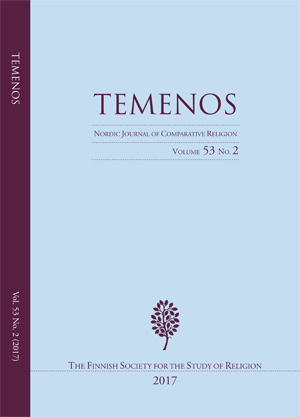Hurting the Qur’an – Suggestions Concerning the Psychological Infrastructure of Desecration
DOI:
https://doi.org/10.33356/temenos.60297Keywords:
Desecration, Qur’an, sacralisation, psychological essentialism, conceptual blendingAbstract
Recent years have witnessed several examples of desecrations of copies of the Qur’an as a display of non-Muslim hostility against Muslims. The present article attempts to answer a fundamental question relating to this phenomenon: how do desecrators know what acts directed at the Qur’an are likely to offend Muslims? The suggestion put forward is that desecration is an act that can be understood across cultural and religious boundaries because it is based on shared, intuitive knowledge of what the sacredness of an object entails. This knowledge, in turn, rests upon certain mental operations involved in the process of sacralisation: i.e. when things are ‘set apart and forbidden’. When the mental processes of psychological essentialism and conceptual blending are combined, it results in a partial personification of the sacred object, providing inferences concerning which acts count as desecrations, i.e. acts that, had they been directed at a person, would cause harm, whether physical or psychological.
Downloads
Published
How to Cite
Issue
Section
License
Copyright (c) 2017 Temenos - Nordic Journal of Comparative Religion

This work is licensed under a Creative Commons Attribution-NonCommercial-NoDerivatives 3.0 Unported License.
Author's Guarantee
- The Author acknowledges that the Work will be publicly accessible on the Internet and that such access will be free of charge for the readers.
- The Author guarantees that the Work is her/his original work that has not been published before and cannot be construed as copying or plagiarism. Furthermore, the Author confirms that the Work contains no statement that is unlawful, defamatory or abusive or in any way infringes the rights of others.
- The Author confirms that she/he has secured all written permissions needed for the reproduction in the Publication of any material created by a third party.
User Rights
Under the CC BY 4.0 license, the Author/s and users are free to:
- Share — copy and redistribute the material in any medium or format,
- Adapt — remix, transform, and build upon the material for any purpose, even commercially,
- However, the Work must be attributed to the original Author and source of publication.
The license of the published metadata is Creative Commons CCO 1.0 Universal (CC0 1.0)
Author Rights
The Authors maintain the right to:
- copyright, and other proprietary rights relating to the Work,
- the right to use the substance of the Work in future own works,
- the right to self-archiving/parallel publishing (publisher's PDF allowed).
Rights of Publisher
- The Publisher reserves the right to make such editorial changes as may be necessary to make the Work suitable for publication in the publication, e.g. style of punctuation, spelling, headings and the like.
- The Publisher will publish the Work if the editorial process is successfully completed and reserves the right not to proceed with publication for whatever reason.
- The publication entitles the author to no royalties or other fees. This agreement will be governed by the laws of Finland.






